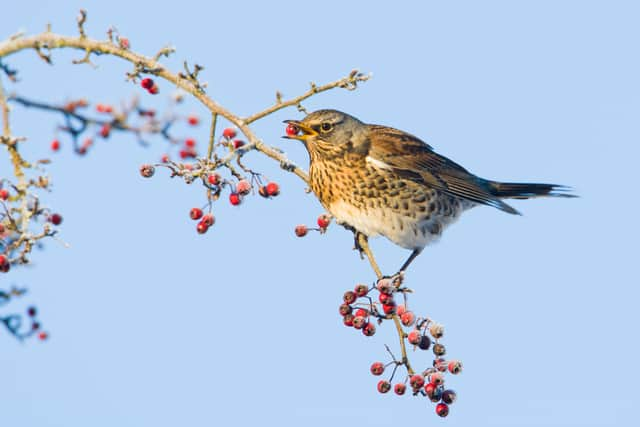Hawthorn berries: bumper autumn crop UK's biggest on record - and it's good news for wildlife
and live on Freeview channel 276
Britain's hedgerows and woodlands are awash in a sea of tangy red, and it heralds good news for migrating birds arriving in the UK for the cold months ahead.
The Woodland Trust believes this autumn may have yielded the biggest crop of hawthorn berries in 20 years of records, with reports from its Nature's Calendar volunteers rating 2023 as 4.2 - or "exceptional" - on the fruit scale. This takes into account dozens of records where hawthorn trees are judged on the abundance of their berries, also known as haws.
Advertisement
Hide AdAdvertisement
Hide AdAlthough records are still coming in, so far this year is on track to have the UK's highest fruit score ever - equalled only by 2014. Woodland Trust citizen science officer Dr Judith Garforth said this was really good autumn news for wildlife.


“Haws are eaten by migrating birds such as redwings, fieldfares and thrushes as well as small mammals," she said. “The fruit score is really important as it provides an indicator of winter food availability for wildlife, as well as the seed source available for natural regeneration of trees and shrubs, [and] it’s often linked to climate variables in preceding seasons.”
The Nature’s Calendar team put the exceptional crop down to a mild spring where temperatures hovered above average. This is when the white hawthorn flowers bloom which, if pollinated, go on to produce the red haw fruits in autumn.
Nature’s Calendar volunteers also record the date that hawthorn flowers first start to open in spring. The data shows that the UK average date when hawthorn trees first began to flower was 1 May this year. The warm dry weather in May was ideal for pollinating insects, the team said.
Advertisement
Hide AdAdvertisement
Hide AdWhilst Dr Garforth celebrated the news, she warned that a shortage of volunteer nature recorders could put their ongoing record gathering efforts at risk. "We desperately need more recorders to deliver such data which is so important for tracking the nation’s seasons.
“We’re incredibly lucky to have historic data going back almost 300 years, but to understand how wildlife is responding to the changing climate, we need new volunteers to continue the record into the future," she continued. “Becoming a recorder is a great way to get into the outdoors but you can even chart nature by looking out of your window. So please do come forward – anyone can take part, you don’t’ need to be scientist!”
If you'd like to find out more about being a Nature's Calendar recorder for the Woodland Trust, you can check out their website here.
Comment Guidelines
National World encourages reader discussion on our stories. User feedback, insights and back-and-forth exchanges add a rich layer of context to reporting. Please review our Community Guidelines before commenting.
